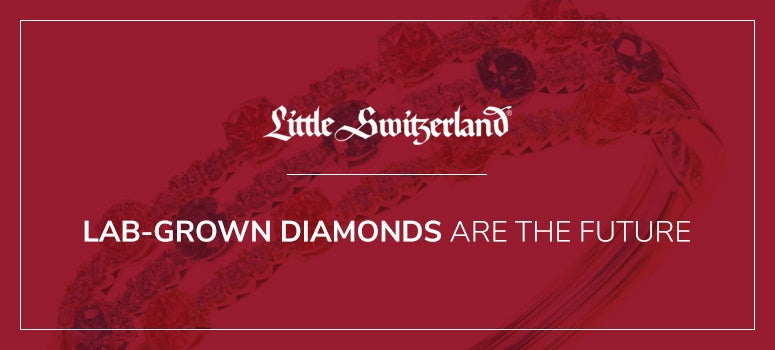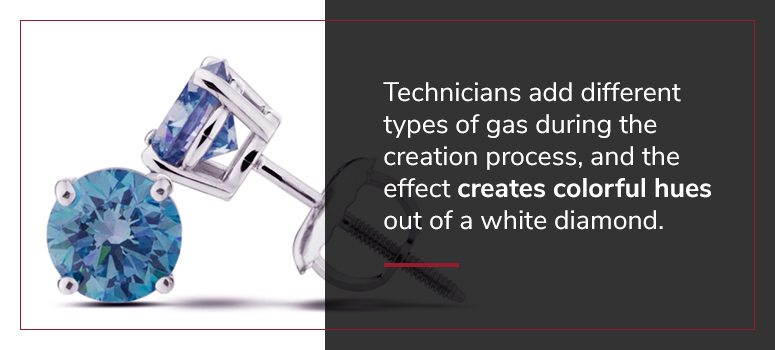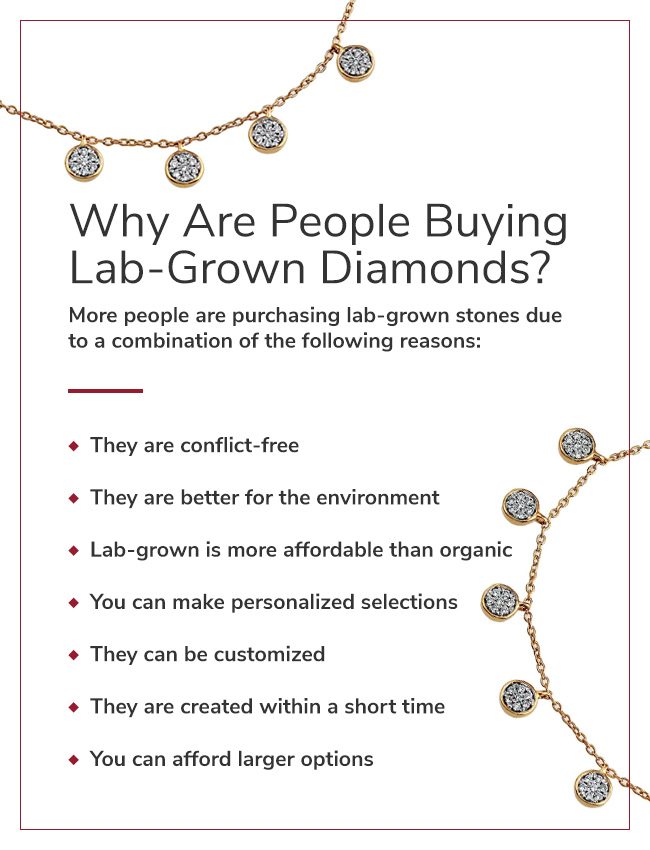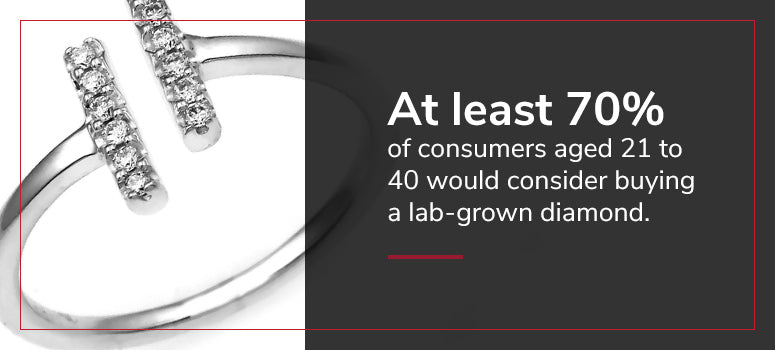Lab-Grown Diamonds Are the Future

In recent years, you may have seen the terms "lab-grown diamonds" or "lab-created diamonds" while jewelry shopping. While lab-grown diamonds differ from mined varieties in some ways, they are still genuine gemstones. More than that, lab-created diamonds are the future of the jewelry world.
In stores or worn by friends and family members, lab-grown diamonds are more widespread now than ever before. You may have encountered lab diamond jewelry before and didn't even realize. Manufactured and mined varieties look nearly identical, as we will explain, but there are some other differences.
With a more ethical creation, manufactured diamonds are climbing their way to be the standard in the jewelry industry. Read on to discover why people are buying lab-grown diamonds in favor of the mined gems.
What Are Lab-Grown Diamonds
Scientists craft lab-grown diamonds in a lab, as the name implies. These manufactured diamonds are chemically identical to their mined counterparts and often cost less as a result of how they are made. Manufacturers use powerful, modern technology to create lab-created diamonds in one of two ways:
- Mimicking natural conditions: Organic diamonds need geological pressure to form. It takes millions of years of conditions to produce diamond material. A diamond created with the High Pressure, High Temperature (HPHT) method is the product of extreme temperature and pressure that mimic natural conditions. Manufacturers apply these conditions to carbon to create what is known as a diamond "seed." The seed can then grow into a larger diamond.
- A process like printing: Three-dimensional printing has become more common over the years, and the diamond industry has joined the trend. In the chemical vapor deposition (CVD) method, manufacturers start with a diamond seed and layer carbon over the diamond in a vacuum to construct a lab-grown gem. While it is a bit more complex than the comparison implies, manufacturers today can essentially print diamonds.
Ever since the development of manufactured diamonds, especially gem-quality ones, there has been a mix of confusion and controversy. Many don't believe that manufactured diamonds are "real," and they don't understand the process. Diamonds didn't arrive on the jewelry scene until the 1970s and 1980s when colored diamonds were created. While production has advanced to include white diamonds, manufacturers still create colorful options. You'll find pink, blue, smoke and other color lab-created diamonds. Scientists manufacture these to supplement the rarity of mined colored diamonds. Scientists add different types of gas during the creation process, and the effect creates colorful hues out of a white diamond.

Lab-crafted white diamonds are young in the jewelry world, appearing in the 21st century. The recent addition of crafted white diamonds prompted the Federal Trade Commission (FTC) to revise its jewelry guide. The FTC ruled that a diamond is a diamond, whether it is organic or lab-created. This is excellent news for individuals hoping to get a lab-grown diamond. The gemstone, which was always a genuine diamond, now has official recognition as such.
The recognition also comes with the acknowledgment that lab-grown diamonds are not "synthetic." They are real diamonds composed of real carbon. Manufactured diamonds have the same properties of an organic diamond. Since you cannot synthesize an element such as carbon, you cannot synthesize a diamond. The recognition gets organic and crafted diamonds a step closer to each other. This comes along with the present similarities.
What Is the Difference Between Organic and Lab-Made Diamond Jewelry?
As you add brilliant diamond jewelry to your collection, you need to choose between mined and manufactured options. Jewelers use lab-grown diamonds in necklaces, rings, earrings and bracelets alike, as they would with mined diamonds. The different names only mark the differences in production. Both lab-created and organic diamonds have the same gemstone properties:
- Crystallized carbon in a cubic crystal system
- A hardness of 10 on the Mohs scale
- A refractive index of 2.42
- A light dispersion of 0.044
- An electron density of 3.52
The same physical and chemical numbers contributed to the FTC's ruling that these varieties of gems are both diamonds. For the consumer, the essential point of these scientific stats is that mined and manufactured diamonds are the same. A cultured diamond is still the hardest gemstone, as its organic counterpart is. Either type of diamond will brilliantly reflect light and shine.
An organic and lab-grown diamond are indistinguishable to the naked eye because of their similar structures. Some comparisons include:
- The carat cost for a mined stone is about $5,000 while manufactured is $3,500, depending on the diamond specifications
- Mined diamond powder polishes both mined and manufactured gems.
- Both mined and lab-created options consist of pure carbon.

It is almost impossible to distinguish mined diamonds from manufactured. The average gemstone wearer won't notice the difference in appearance between the two. If you want larger diamonds or many pieces for your collection, crafted gems are a better choice. The reason is the only difference consumers will see — the price.
Some suspect that a lower cost equates to lower value over time, but lab-grown diamonds are still a valuable gemstone despite coming at a lower price. It takes manufacturers up to three months to produce a diamond, and they need to cover the costs of running their labs. Lab diamond jewelry still comes at the cost you'd expect to see from high-quality gemstone jewelry, but it will be lower than mined diamonds. Along with the price appeal, people are buying lab-grown diamond jewelry for other intriguing reasons.
Why Are People Buying Lab-Grown Diamonds?

Lab-grown diamonds have gained enough traction to become the future of the diamond industry. While they are more common, you may ask yourself why people are buying lab-created diamonds. The variety of gem comes with benefits, both for the world and the consumer. More people are purchasing lab-grown stones due to a combination of the following reasons:
- They are conflict-free: Nearly two-thirds (65%) of the world's diamonds are mined in Africa, and the mining industry there is plagued by controversial practices. Forced labor, demanding conditions and other factors made mining diamonds unethical. The diamond industry established the Kimberley Process and set a standard for conflict-free gems in 2003. However, some mined diamonds still come from unethical sources. With a lab-grown diamond, you don't have to worry about unethical treatment. Scientists produce the gems in a responsible way in their labs with no forced labor or harsh conditions.
- They are better for the environment: Mining diamonds requires excessive harm to the planet through digging or drilling into the ground. Those processes may involve deforestation and can cause soil erosion. Mined diamonds also need large amounts of water to mine and create higher air emissions than that of a crafted gem. Manufactured diamonds don't have the same environmental impact as mined gems since scientists make them in a lab. If a diamond manufacturer uses sustainable energy, like that of wind turbines, they lessen a diamond's impact on the environment even more.
- Lab-grown is more affordable than mined : Crafted diamonds cost up to 40% less than mined diamonds. Manufactured stones make an excellent selection for any occasion jewelry. If you do not currently own a diamond necklace, bracelet, watch or earrings, a piece with lab-created diamonds is a stunning and smart option. Even lab diamond engagement rings are becoming the standard because of their lower price and ethical production.
- You can make personalized selections: Manufactured diamonds come in an array of colors, cuts and designs. If you're purchasing diamond jewelry for you or someone you know, find a brilliant variety when you expand your search to include lab-grown gems. Mined colored diamonds are rare and thus have a higher price, but lab-grown options come in an array of hues.
- They can be customized: Certain manufacturers offer customizable diamonds. Sometimes you can choose the color, shape and size of the gemstone through these processes. Even if you cannot find a manufacturer to custom-create a diamond, your options are extensive when it comes to pre-made manufactured diamonds.
- They are created within a short time: As we've mentioned before, lab-created diamonds can take between a few weeks to a few months to produce. When compared to the millions of years it takes for an organic diamond to form, you can see why lab-grown diamonds are more cost-effective.
- You can afford larger options: Because of the price difference, you can take the same amount you'd spend on an organic diamond and buy a crafted stone that's about 50% larger. If a bigger gem does not fit your style, you could always choose a high-quality lab-created diamond for the same price of a lesser mined gem.
The innovation of lab-grown stones makes them the future of diamonds in the jewelry industry. We use technology for almost everything in the present day, so we should embrace the same process for growing diamonds. When they come with so many benefits, lab-grown diamonds are a positive trend for the world.
Human-made gems are a trend that has already occurred within the pearl industry. Like lab-grown diamonds, cultured pearls begin with a seed added to an oyster by hand. Nearly all pearls purchased today are cultured varieties. If buyers and the jewelry world have come to favor cultured pearls, cultured diamonds are likely the future of diamonds.
Millennials Are Investing in Lab-Grown Diamonds

Another factor driving the lab-grown gem market is the fact that millennials are buying. With most of the above reasons convincing them, millennials prefer buying manufactured diamonds. At least 70% of consumers aged 21 to 40 would consider buying a lab-created diamond. As a generation, millennials tend to be:
- Socially conscious
- Environmentally-minded
- Looking for affordable alternatives
Millennials and other conscious buyers also appreciate a level of transparency when they make purchases, especially more significant jewelry purchases. There is inherent transparency with lab diamond jewelry. Consumers will buy knowing that their gem comes with all of the positives above.
Millennials' traits make lab-grown diamonds a perfect choice for them. As this generation ages, they help create trends in the jewelry world. Celebrities and other well-known individuals are already getting on the trend, influencing even more from the younger generation to join.
Why Are Lab-Grown Diamonds the Future
Lab-grown diamonds are the future because we may eventually run out of organic options. Natural sources create mined diamonds in a process that takes millions of years. We may soon see the depletion of the earth's diamond supply as a result. As the demand for diamonds and jewelry increases, more diamonds must be mined to fulfill the demand. Many deem the current pace of diamond mining unsustainable.
We could buy only vintage diamond jewelry or explore other gemstone options. There is a tradition, though, with brilliant diamond jewelry. From pieces for formal occasions to meaningful engagement rings, diamonds should be forever.
Lab-grown diamonds become the solution to other unsustainable practices. The practice of creating diamonds in a lab will be around for years to come because it's better for the environment than traditional mining. With the same chemical and physical properties evaluated under the same guidelines as mined diamonds, lab-created varieties are of comparable quality to mined diamonds. The FTC measures the same traits as they do with other diamonds:
- Cut
- Color
- Clarity
- Carat
You'll find the same high-quality characteristics between manufactured and mined diamonds. Scientists have more control over the lab-grown process than we ever could with organic diamonds. More control means equal and sometimes higher quality. The comparable quality contributes to cultured diamond's popularity, but some reasons are too good to beat. The top five reasons why crafted diamonds are the future of the diamond industry are:
- Scientists can create diamonds in a few weeks.
- They are 100% real diamonds.
- Lab diamond jewelry is still as luxurious as mined.
- Conflict free
- They come in a variety of designs and colors and are a very personal gift.
On top of all the perks, lab-grown diamonds are still unique. No two mined diamonds are the same, and no two manufactured gems are the same. We aren't sacrificing high-quality or unique pieces by choosing lab-grown gemstones. Instead, we promote conflict-free processes and methods that are better for the environment. As trends change, those processes may improve even more.
Diamond jewelry trends shift toward lab-grown stones, and manufacturing may become more efficient. We may see more customizable options, a more extensive array of colors and a shorter turnover time.
Shop at Little Switzerland for Lab-Grown Diamonds
Step into the future and get your lab diamond jewelry today. When you're ready to get the same look of mined diamonds with the benefits of lab-grown, shop with us at Little Switzerland. Browse our Engrace Diamonds assortment of lab-created diamond jewelry to see the future of diamonds.
We offer stunning pieces in white and colored gem varieties. Contact us at Little Switzerland, and let us help you expand your jewelry collection. If you've already begun to explore the trend, expand your lab-grown diamond assortment today.



